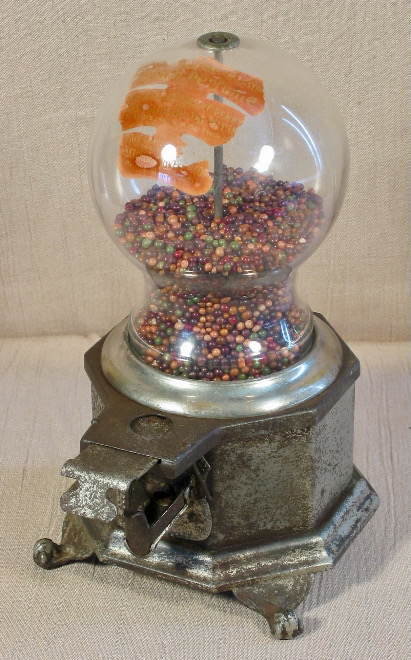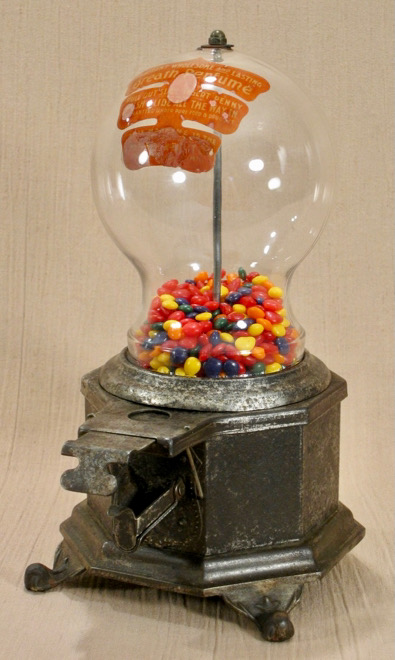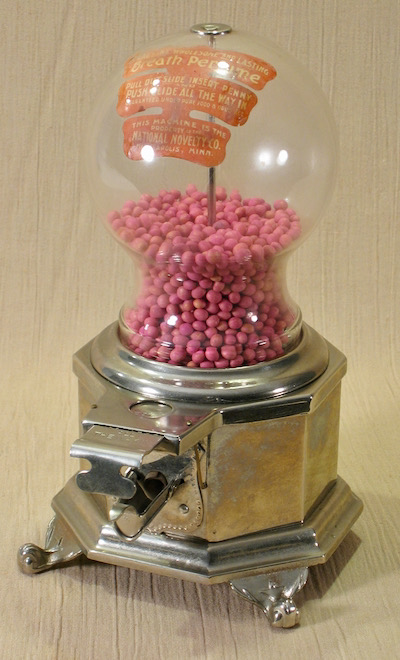___________________________________________________________________________________________
National Breath Pellet



___________________________________________________________________________________________



National Novelty Co., c. 1910, 10 1/2". Some collectors think that the price of an antique gum or peanut machine is often inversely proportional to its size. Those who espouse that hypothesis sometimes use this model as an example to argue their point. Those who don't believe in that correlation refute it by citing the Lion vendor. In the end these arguments are usually resolved by arm wrestling, with the loser buying the beer.
This is a great little machine, and I do mean little. Next to the 8 1/2" Hance Breath Pellet it looks pretty substantial, but next to just about any other machine it looks like the pipsqueak that it is. It's made of nickel-plated sheet metal or cast iron and has one of the most identifiable globes I know of. They were made to vend teensy tiny breath pellets, and therefore gave small portions that required small amounts of product and needed only small globes. The ring surrounding the base of the globe looks to be aluminum on some examples and sheet metal or cast iron on others. That would explain why it has a different finish than the body does in the left picture above and why the patina matches the body's in the middle picture. As I type this I have access to the machine in the middle and just confirmed that a magnet sticks strongly to that ring, so there's that clue as well.
National Breath Pellet machines are considered rare but I've seen enough to now believe they're quite scarce but not Officially Rare. I've owned 4 myself; the first was replated and isn't pictured above, the other 3 are. In order from left to right:
Bill Enes made his living as a dealer of antique vending machines, which involved hauling machines to and from various shows around the US. He's known best for authoring Silent Salesmen and the expanded sequel Silent Salesmen Too, but those books were possible because of the knowledge he'd acquired during years of buying, selling, and researching antique vendors. I saw him at shows in Southern California and in the Chicago area, and know that he also attended shows on the east coast. He lived in Lenexa, KS, which is about the mid-point of the country, so the entire country was within driving range.
Bill died suddenly in 1999 when an aneurysm burst while he was at home. He was unloading things from his van into the house, and was walking from the house to the van for another armload when he collapsed. The ambulance arrived quickly but the EMT's couldn't do anything; he was already gone. In the immediate aftermath of that event someone closed up the van and locked it, and the van remained there untouched for the next 18 years.
After Bill died, his widow Peggy continued to live in the house until about 2017, and then she moved. I don't know what condition the van was in by then, but it couldn't have been good. I also don't know what the plan for the van was when she moved, but I'd guess that the resale value of a 1990's van that had sat idle outside in Kansas weather for 18 years was close to zero. Whatever the plan was, before they parted with it someone got the bright idea to look inside to see what was there. Someone did that, and in the back of the van found a treasure trove of old vending machines, which Bill had been unloading into the house when he died. They'd sat in the van for 18 years, through frigid winters and hot, sticky summers without anyone knowing about them.
This National Breath Pellet is one of the machines found in the van. It's a nice example of the model even without knowing its provenance, but knowing the story behind it makes this even more special. A Griswold Red Star peanut machine was another one found in that van, which you can see and read about here.
___________________________________________________________________________________________
___________________________________________________________________________________________
©Small Vintage Vending 2021